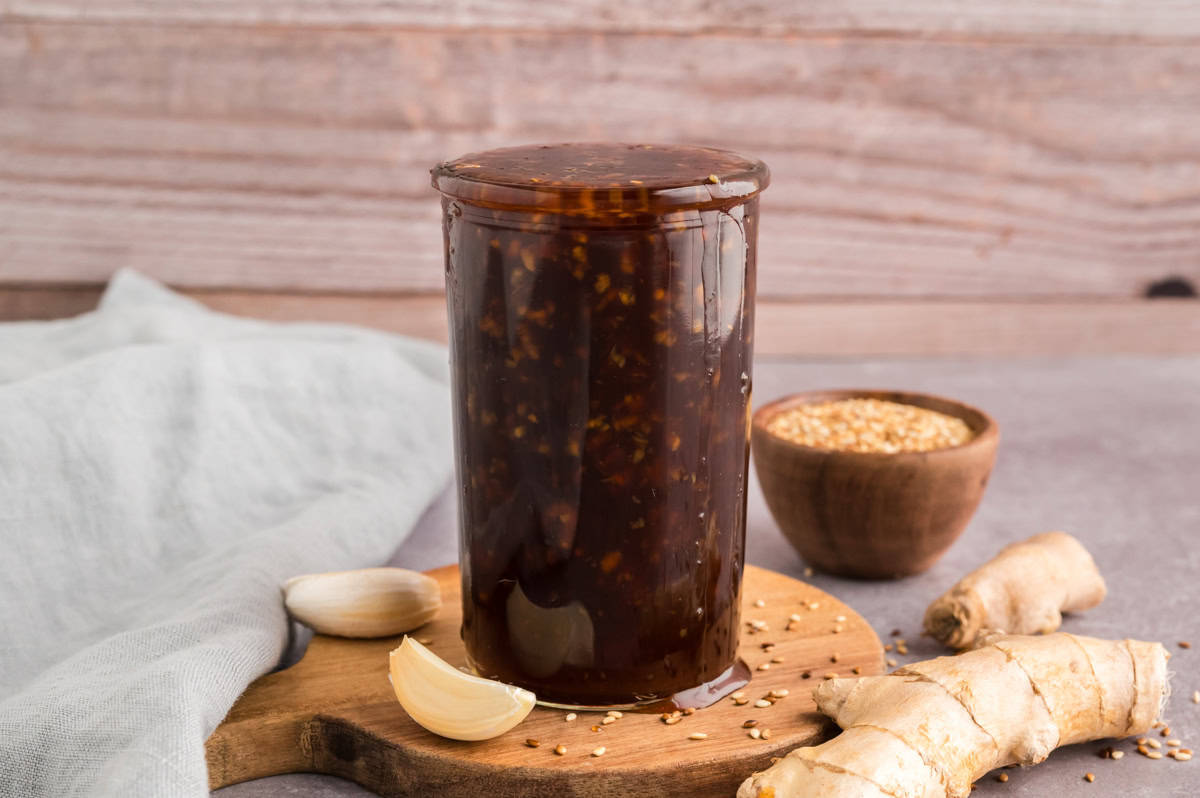I love making this Korean BBQ sauce because it brings so much flavor to any meal. It’s a simple way to add a little spice and sweetness that makes everything taste special. I can’t wait for you to try it and see how it changes your cooking game.
Some ingredients like gochujang might be new if you haven’t cooked Korean food before. It’s a spicy and slightly sweet chili paste that you can usually find in the international or Asian section of most supermarkets. Sesame oil is another ingredient that adds a nutty flavor, so if you don’t have it, look for it near other oils or Asian sauces.

Ingredients For Korean BBQ Sauce Recipe
Soy sauce: A salty and savory base that adds depth to the sauce.
Brown sugar: Adds sweetness and helps balance the spicy and salty flavors.
Rice vinegar: Gives a mild tanginess that brightens the sauce.
Sesame oil: Adds a rich, nutty flavor that’s key in Korean cooking.
Gochujang: A Korean chili paste that brings heat and a bit of sweetness.
Garlic: Fresh garlic adds a sharp, aromatic punch.
Ginger: Adds a warm, slightly spicy flavor that complements the garlic.
Water: Used to thin out the sauce and help everything blend together.
Technique Tip for Perfecting This Sauce
One of the most helpful moves in making this Korean BBQ Sauce is learning how to whisk without splashing. When you mix all the ingredients—like soy sauce, brown sugar, and gochujang—you want everything to blend smoothly without making a mess. Here’s how you can do it step by step:
- Use a whisk that fits comfortably in your saucepan. A whisk that’s too big or too small can make it harder to control.
- Hold the whisk near the handle, not too far back, so you have better control.
- Start whisking slowly in small circles or figure eights. This helps mix the ingredients gently at first.
- Gradually increase your speed as the ingredients start to combine, but keep your whisk mostly under the surface of the liquid.
- If you see splashes, slow down a bit and keep the whisk deeper in the sauce.
Whisking this way helps the brown sugar dissolve evenly and stops the gochujang and garlic from clumping. It also keeps your stove and counter clean, which means less cleanup later. Plus, a smooth sauce tastes better because all the flavors get to mix just right.
When I first made this sauce, I was so excited that I whisked too fast and ended up with sauce all over the stove! Now, I remind myself to start slow and keep the whisk under the surface. Also, if you don’t have a whisk, a fork can work in a pinch, just be gentle. This little trick makes cooking more fun and less messy, so you can focus on tasting your delicious Korean BBQ sauce at the end.
Suggested Side Dishes
Alternative Ingredients
soy sauce - Substitute with tamari: Tamari is a gluten-free alternative that provides a similar salty and umami flavor profile.
brown sugar - Substitute with honey: Honey adds sweetness and a slight floral note, which can complement the other flavors in the sauce.
rice vinegar - Substitute with apple cider vinegar: Apple cider vinegar has a similar acidity level and a mild fruity flavor that works well in place of rice vinegar.
sesame oil - Substitute with olive oil: Olive oil can be used for its rich texture, though it lacks the nutty flavor of sesame oil. Add a small amount of toasted sesame seeds to mimic the sesame flavor.
gochujang - Substitute with sriracha: Sriracha provides heat and a touch of sweetness, though it lacks the fermented depth of gochujang. Add a bit of miso paste if available to enhance the umami.
garlic - Substitute with garlic powder: Garlic powder can be used in place of fresh garlic, though it may lack the pungency and freshness. Use about ¼ teaspoon of garlic powder per clove.
ginger - Substitute with ground ginger: Ground ginger can replace fresh ginger, though it has a more concentrated flavor. Use about ¼ teaspoon of ground ginger per teaspoon of fresh ginger.
water - Substitute with vegetable broth: Vegetable broth adds depth and a slight savory note, enhancing the overall flavor of the sauce.
Alternative Recipes Similar to This Sauce
How to Store or Freeze This Sauce
Allow the Korean BBQ sauce to cool completely before storing. This prevents condensation, which can alter the sauce's texture and flavor.
Transfer the sauce into an airtight container or a clean glass jar. Ensure the container is completely dry before use to maintain the sauce's integrity.
Store the sauce in the refrigerator. It will keep well for up to two weeks, allowing the flavors to meld and deepen over time.
For longer storage, consider freezing the sauce. Pour it into a freezer-safe container or use ice cube trays for portioned servings. Once frozen, transfer the cubes to a resealable plastic bag for easy access.
When ready to use, thaw the desired amount of sauce in the refrigerator overnight. Avoid microwaving to defrost, as this can affect the sauce's consistency.
If the sauce appears too thick after thawing, gently reheat it on the stove over low heat, adding a splash of water or soy sauce to achieve the desired consistency.
Always use a clean spoon or utensil when scooping out the sauce to prevent contamination and extend its shelf life.
Consider labeling the container with the date of preparation to keep track of freshness, ensuring you always enjoy the sauce at its peak flavor.
How to Reheat Leftovers
Gently warm the Korean BBQ sauce in a small saucepan over low heat, stirring occasionally to ensure even heating and prevent sticking. This method preserves the sauce's rich flavors and silky texture.
Use a microwave-safe bowl to reheat the sauce in the microwave. Cover the bowl with a microwave-safe lid or wrap to avoid splatters. Heat in short bursts of 15-20 seconds, stirring in between, until the sauce reaches your desired temperature.
For a quick and easy method, place the sauce in a heatproof bowl and set it over a pot of simmering water, creating a makeshift double boiler. Stir occasionally until the sauce is warmed through, ensuring it doesn't overheat or separate.
If you're planning to use the sauce as a glaze for grilled meats, brush it directly onto the meat during the last few minutes of cooking. This allows the sauce to heat up and caramelize slightly, enhancing the barbecue flavors.
To infuse the sauce with additional depth, add a splash of water or broth to a skillet, then pour in the sauce. Heat gently over medium-low heat, stirring occasionally, until warmed through. This method can also help if the sauce has thickened too much in the fridge.
Essential Tools for Making This Sauce
Saucepan: A medium-sized pan used to combine and heat the ingredients, allowing them to simmer and meld together.
Whisk: A tool used to mix the ingredients thoroughly, ensuring the sauce has a smooth and consistent texture.
Measuring cups: Used to accurately measure the liquid ingredients like soy sauce, rice vinegar, and water.
Measuring spoons: Essential for measuring smaller quantities of ingredients such as sesame oil and gochujang.
Garlic press: Handy for mincing garlic quickly and efficiently, ensuring it blends well into the sauce.
Grater: Useful for mincing ginger finely, which helps distribute its flavor evenly throughout the sauce.
Airtight container: Necessary for storing the sauce in the refrigerator, keeping it fresh and flavorful for future use.
How to Save Time on This Recipe
Prep ingredients in advance: Mince the garlic and ginger ahead of time and store them in the fridge to save time when making the sauce.
Use a blender: Combine all the ingredients in a blender and blend until smooth. This saves time on whisking and ensures a well-mixed sauce.
Batch cooking: Double or triple the recipe and store extra sauce in the freezer for future use, cutting down on prep time for future meals.
Quick cooling: Pour the hot sauce into a shallow dish to cool it faster before storing.

Korean BBQ Sauce Recipe
Ingredients
Main Ingredients
- ½ cup soy sauce
- ¼ cup brown sugar
- 2 tablespoon rice vinegar
- 2 tablespoon sesame oil
- 1 tablespoon gochujang (Korean chili paste)
- 3 cloves garlic, minced
- 1 teaspoon ginger, minced
- ¼ cup water
Instructions
- In a saucepan, combine all the ingredients.
- Whisk together and bring to a simmer over medium heat.
- Reduce heat to low and let it simmer for about 10 minutes, stirring occasionally.
- Remove from heat and let it cool. Store in an airtight container in the refrigerator.
Nutritional Value
Keywords
More Amazing Recipes to Try 🙂
- Date Nut Bread Recipe1 Hours 15 Minutes
- Romaine Salad Recipe10 Minutes
- Beef Tips and Noodles Recipe1 Hours
- Thanksgiving Turkey Recipe4 Hours 30 Minutes
- Chocolate Eclair Dessert Recipe30 Minutes
- Chicken Soup Base Recipe1 Hours
- Wild Mushroom Puff Pastry Recipe45 Minutes
- Philly Oreo Cheesecake Recipe1 Hours 5 Minutes


Leave a Reply